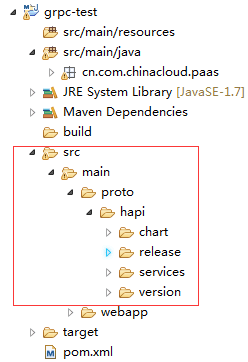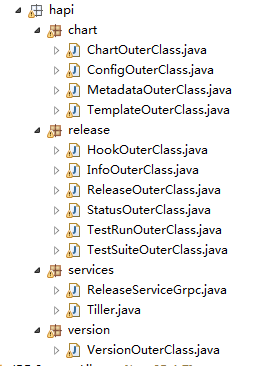共计 12540 个字符,预计需要花费 32 分钟才能阅读完成。
1. 什么是 helm?
首先说说什么是 helm,引用 helm 原话“The Kubernetes Package Manager”—— k8s 的包管理器。
2. 为何要用 helm?or 用 helm 有什么好处?
用过 k8s 的人都知道,k8s 的 replicationcontroller、service、pod 这些的创建都需要一个配置的 yaml 文件,而如果你的环境比较繁琐时你会有很多 yaml,如果你想修改某个值且这个值用的地方很多那么问题就来了,真心显得比较麻烦。如果你要更新部署呢?那么就更是麻烦了,而 helm 可以帮你解决这些麻烦。还有一个优点是 helm 已经有很多开源应用的库。
For 想了解更多的同学们:这里有两个连接 一个是 k8s 的 一个是 helm 的网站。k8s:点击打开链接 helm github:点击打开链接
3. 使用 maven gRPC 插件生成 helm(Till)客户端 sdk(实际是一堆 Java 文件)
a、建立 maven 项目配置 maven gRPC 插件,配置如下:
<project xmlns=”http://maven.apache.org/POM/4.0.0″ xmlns:xsi=”http://www.w3.org/2001/XMLSchema-instance”
xsi:schemaLocation=”http://maven.apache.org/POM/4.0.0 http://maven.apache.org/maven-v4_0_0.xsd”>
<modelVersion>4.0.0</modelVersion>
<groupId>chinacloud.com.cn</groupId>
<artifactId>grpc</artifactId>
<packaging>jar</packaging>
<version>0.0.1-SNAPSHOT</version>
<name>grpc Maven Webapp</name>
<url>http://maven.apache.org</url>
<properties>
<grpc.version>1.0.3</grpc.version>
</properties>
<dependencies>
<dependency>
<groupId>junit</groupId>
<artifactId>junit</artifactId>
<version>3.8.1</version>
<scope>test</scope>
</dependency>
<!– gRPC –>
<dependency>
<groupId>io.grpc</groupId>
<artifactId>grpc-netty</artifactId>
<version>${grpc.version}</version>
</dependency>
<dependency>
<groupId>io.grpc</groupId>
<artifactId>grpc-protobuf</artifactId>
<version>${grpc.version}</version>
</dependency>
<dependency>
<groupId>io.grpc</groupId>
<artifactId>grpc-stub</artifactId>
<version>${grpc.version}</version>
</dependency>
</dependencies>
<build>
<finalName>grpc</finalName>
<extensions>
<extension>
<groupId>kr.motd.maven</groupId>
<artifactId>os-maven-plugin</artifactId>
<version>1.4.1.Final</version>
</extension>
</extensions>
<plugins>
<!–This plugin’s configuration is used to store Eclipse m2e settings only. It has no influence on the Maven build
itself. –>
<plugin>
<groupId>org.eclipse.m2e</groupId>
<artifactId>lifecycle-mapping</artifactId>
<version>1.0.0</version>
<configuration>
<lifecycleMappingMetadata>
<pluginExecutions>
<pluginExecution>
<pluginExecutionFilter>
<groupId>
org.apache.maven.plugins
</groupId>
<artifactId>
maven-compiler-plugin
</artifactId>
<versionRange>
[2.5.1,)
</versionRange>
<goals>
<goal>compile</goal>
</goals>
</pluginExecutionFilter>
<action>
<ignore></ignore>
</action>
</pluginExecution>
</pluginExecutions>
</lifecycleMappingMetadata>
</configuration>
</plugin>
<plugin>
<groupId>org.xolstice.maven.plugins</groupId>
<artifactId>protobuf-maven-plugin</artifactId>
<version>0.5.0</version>
<configuration>
<protocArtifact>com.google.protobuf:protoc:3.0.2:exe:${os.detected.classifier}</protocArtifact>
<pluginId>grpc-java</pluginId>
<pluginArtifact>io.grpc:protoc-gen-grpc-java:${grpc.version}:exe:${os.detected.classifier}</pluginArtifact>
</configuration>
<executions>
<execution>
<goals>
<goal>compile</goal>
<goal>compile-custom</goal>
</goals>
</execution>
</executions>
</plugin>
</plugins>
</build>
</project>
b. 在 helm 官网 找到 Tiller 的 hapi proto 文件用来生成 java 代码,同时把这些文件放在 src/main/proto 文件中

c. 运行 protobuf:compile taget 文件夹能找到生成的 java 文件,然后考到 src/main/java 如图:

4. 起飞,在 main 函数调用 Tiller 的 service 方法,前提 helm 以及 k8s 都已有环境。如下是起飞 main 方法:
public static void main(String[] args) throws InterruptedException {
// ManagedChannel channel = ManagedChannelBuilder.forAddress(“172.16.101.200”, 44134).usePlaintext(true).build();
ManagedChannel channel = NettyChannelBuilder
.forAddress(“172.16.80.151”, 44134)
.negotiationType(NegotiationType.PLAINTEXT).build();
ReleaseServiceGrpc.ReleaseServiceBlockingStub blockingStub = ReleaseServiceGrpc
.newBlockingStub(channel).withCallCredentials(new CallCredentials(){
@Override
public void applyRequestMetadata(MethodDescriptor<?, ?> method, Attributes attrs,
Executor appExecutor, MetadataApplier applier) {
// TODO Auto-generated method stub
Metadata metadata = new Metadata();
metadata.put(Metadata.Key.of(“x-helm-api-client”, Metadata.ASCII_STRING_MARSHALLER), “v2.2.0”);
applier.apply(metadata);
}
});
//deployAChart(blockingStub);
//updateDeploy(blockingStub);
//undeploy(blockingStub);
Tiller.GetVersionResponse response = blockingStub.getVersion(Tiller.GetVersionRequest.newBuilder().build());
System.out.println(response.getVersion());
Iterator<Tiller.ListReleasesResponse> listReleasesIterator = blockingStub.listReleases(Tiller.ListReleasesRequest.newBuilder().build());
System.out.println(“================start=================”);
while (listReleasesIterator.hasNext()) {
System.out.println(listReleasesIterator.next());
System.out.println(“———————————“);
}
System.out.println(“================end=================”);
Tiller.GetReleaseStatusResponse releaseStatus = blockingStub.getReleaseStatus(Tiller.GetReleaseStatusRequest
.newBuilder()
.setName(“invited-catfish”).build());
System.out.println(“status:”+releaseStatus);
System.out.println(“—————–“);
Tiller.GetHistoryResponse history = blockingStub.getHistory(Tiller.GetHistoryRequest.newBuilder()
.setName(“invited-catfish”).setMax(10).build());
System.out.println(history);
try {
channel.shutdown().awaitTermination(5, TimeUnit.SECONDS);
} catch (InterruptedException e) {
e.printStackTrace();
}
}
5. 提出运行结果
releases {
name: “full-meerkat”
info {
status {
code: DEPLOYED
notes: “1. Get the application URL by running these commands:\n export POD_NAME=$(kubectl get pods –namespace default -l \”app=full-meerkat-test\” -o jsonpath=\”{.items[0].metadata.name}\”)\n echo \”Visit http://127.0.0.1:8080 to use your application\”\n kubectl port-forward $POD_NAME 8080:80\n”
}
first_deployed {
seconds: 1489569670
nanos: 350911984
}
last_deployed {
seconds: 1489569670
nanos: 350911984
}
Description: “Install complete”
}
chart {
metadata {
name: “test”
version: “0.1.0”
description: “A Helm chart for Kubernetes”
apiVersion: “v1”
}
templates {
name: “templates/NOTES.txt”
data: “1. Get the application URL by running these commands:\n{{- if contains \”NodePort\” .Values.service.type}}\n export NODE_PORT=$(kubectl get –namespace {{ .Release.Namespace}} -o jsonpath=\”{.spec.ports[0].nodePort}\” services {{template \”fullname\” .}})\n export NODE_IP=$(kubectl get nodes –namespace {{ .Release.Namespace}} -o jsonpath=\”{.items[0].status.addresses[0].address}\”)\n echo http://$NODE_IP:$NODE_PORT/login\n{{- else if contains \”LoadBalancer\” .Values.service.type}}\n NOTE: It may take a few minutes for the LoadBalancer IP to be available.\n You can watch the status of by running \’kubectl get svc -w {{template \”fullname\” .}}\’\n export SERVICE_IP=$(kubectl get svc –namespace {{ .Release.Namespace}} {{template \”fullname\” .}} -o jsonpath=\'{.status.loadBalancer.ingress[0].ip}\’)\n echo http://$SERVICE_IP:{{.Values.service.externalPort}}\n{{- else if contains \”ClusterIP\” .Values.service.type}}\n export POD_NAME=$(kubectl get pods –namespace {{ .Release.Namespace}} -l \”app={{template \”fullname\” .}}\” -o jsonpath=\”{.items[0].metadata.name}\”)\n echo \”Visit http://127.0.0.1:8080 to use your application\”\n kubectl port-forward $POD_NAME 8080:{{.Values.service.externalPort}}\n{{- end}}\n”
}
templates {
name: “templates/_helpers.tpl”
data: “{{/* vim: set filetype=mustache: */}}\n{{/*\nExpand the name of the chart.\n*/}}\n{{- define \”name\” -}}\n{{- default .Chart.Name .Values.nameOverride | trunc 63 | trimSuffix \”-\” -}}\n{{- end -}}\n\n{{/*\nCreate a default fully qualified app name.\nWe truncate at 63 chars because some Kubernetes name fields are limited to this (by the DNS naming spec).\n*/}}\n{{- define \”fullname\” -}}\n{{- $name := default .Chart.Name .Values.nameOverride -}}\n{{- printf \”%s-%s\” .Release.Name $name | trunc 63 | trimSuffix \”-\” -}}\n{{- end -}}\n”
}
templates {
name: “templates/configMap.yaml”
data: “apiVersion: v1\r\nkind: ConfigMap\r\nmetadata:\r\n name: {{template \”fullname\” .}}-cfgmap\r\n # annotations:\r\n # # This is what defines this resource as a hook. Without this line, the\r\n # # job is considered part of the release.\r\n # \”helm.sh/hook\”: pre-install\r\ndata:\r\n dessert: {{.Values.dessert}}\r\n test: {{.Release.Revision}}-{{.Release.IsUpgrade}}-{{.Release.IsInstall}}\r\n”
}
templates {
name: “templates/deployment.yaml”
data: “apiVersion: extensions/v1beta1\nkind: Deployment\nmetadata:\n name: {{template \”fullname\” .}}\n labels:\n chart: \”{{.Chart.Name}}-{{.Chart.Version}}\”\nspec:\n replicas: {{.Values.replicaCount}}\n template:\n metadata:\n labels:\n app: {{template \”fullname\” .}}\n annotations:\n pod.beta.kubernetes.io/init-containers: \'[\n {\n \”name\”: \”remove-lost-found\”,\n \”image\”: \”busybox:1.25.0\”,\n \”command\”: [\”rm\”, \”-fr\”, \”/var/lib/MySQL/lost+found\”],\n \”volumeMounts\”: [\n {\n \”name\”: \”data\”,\n \”mountPath\”: \”/var/lib/mysql\”\n}\n ],\n \”imagePullPolicy\”: {{.Values.imagePullPolicy | quote}}\n }\n ]\’\n spec:\n containers:\n – name: {{.Chart.Name}}\n image: \”{{.Values.image.repository}}:{{.Values.image.tag}}\”\n imagePullPolicy: {{.Values.image.pullPolicy}}\n ports:\n – containerPort: {{.Values.service.internalPort}}\n livenessProbe:\n httpGet:\n path: /\n port: {{.Values.service.internalPort}}\n readinessProbe:\n httpGet:\n path: /\n port: {{.Values.service.internalPort}}\n resources:\n{{toYaml .Values.resources | indent 12}}\n”
}
templates {
name: “templates/service.yaml”
data: “apiVersion: v1\nkind: Service\nmetadata:\n name: {{template \”fullname\” .}}\n labels:\n chart: \”{{.Chart.Name}}-{{.Chart.Version | replace \”+\” \”_\”}}\”\nspec:\n type: {{.Values.service.type}}\n ports:\n – port: {{.Values.service.externalPort}}\n targetPort: {{.Values.service.internalPort}}\n protocol: TCP\n name: {{.Values.service.name}}\n selector:\n app: {{template \”fullname\” .}}\n”
}
values {
raw: “# Default values for test.\n# This is a YAML-formatted file.\n# Declare variables to be passed into your templates.\nreplicaCount: 1\nimage:\n repository: 172.16.101.192/common/nginx\n tag: 1.8.1\n pullPolicy: IfNotPresent\nservice:\n name: nginx\n type: ClusterIP\n externalPort: 80\n internalPort: 80\nresources:\n limits:\n cpu: 200m\n memory: 128Mi\n requests:\n cpu: 200m\n memory: 128Mi\ndessert: cake\n\n”
}
files {
type_url: “.helmignore”
value: “# Patterns to ignore when building packages.\n# This supports shell glob matching, relative path matching, and\n# negation (prefixed with !). Only one pattern per line.\n.DS_Store\n# Common VCS dirs\n.git/\n.gitignore\n.bzr/\n.bzrignore\n.hg/\n.hgignore\n.svn/\n# Common backup files\n*.swp\n*.bak\n*.tmp\n*~\n# Various IDEs\n.project\n.idea/\n*.tmproj\n”
}
}
config {
raw: “{}\n”
}
manifest: “\n—\n# Source: test/templates/configMap.yaml\napiVersion: v1\r\nkind: ConfigMap\r\nmetadata:\r\n name: full-meerkat-test-cfgmap\r\n # annotations:\r\n # # This is what defines this resource as a hook. Without this line, the\r\n # # job is considered part of the release.\r\n # \”helm.sh/hook\”: pre-install\r\ndata:\r\n dessert: cake\r\n test: 1-false-true\r\n\n—\n# Source: test/templates/service.yaml\napiVersion: v1\nkind: Service\nmetadata:\n name: full-meerkat-test\n labels:\n chart: \”test-0.1.0\”\nspec:\n type: ClusterIP\n ports:\n – port: 80\n targetPort: 80\n protocol: TCP\n name: nginx\n selector:\n app: full-meerkat-test\n\n—\n# Source: test/templates/deployment.yaml\napiVersion: extensions/v1beta1\nkind: Deployment\nmetadata:\n name: full-meerkat-test\n labels:\n chart: \”test-0.1.0\”\nspec:\n replicas: 1\n template:\n metadata:\n labels:\n app: full-meerkat-test\n annotations:\n pod.beta.kubernetes.io/init-containers: \'[\n {\n \”name\”: \”remove-lost-found\”,\n \”image\”: \”busybox:1.25.0\”,\n \”command\”: [\”rm\”, \”-fr\”, \”/var/lib/mysql/lost+found\”],\n \”volumeMounts\”: [\n {\n \”name\”: \”data\”,\n \”mountPath\”: \”/var/lib/mysql\”\n}\n ],\n \”imagePullPolicy\”: \n }\n ]\’\n spec:\n containers:\n – name: test\n image: \”172.16.101.192/common/nginx:1.8.1\”\n imagePullPolicy: IfNotPresent\n ports:\n – containerPort: 80\n livenessProbe:\n httpGet:\n path: /\n port: 80\n readinessProbe:\n httpGet:\n path: /\n port: 80\n resources:\n limits:\n cpu: 200m\n memory: 128Mi\n requests:\n cpu: 200m\n memory: 128Mi\n \n”
version: 1
namespace: “default”
}
本文永久更新链接地址 :http://www.linuxidc.com/Linux/2017-06/144786.htm
















